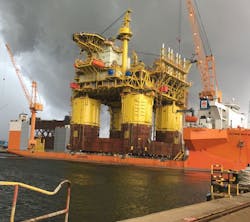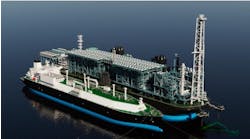Offshore staff
KUALA LUMPUR, Malaysia – IEV Malaysia has started mobilization for the offshore transportation and installation of Sabah Shell’s Malikai TLP.
Under a joint venture with Heerema Marine Contractors, theSapura 3000 and Aegirconstruction vessels, assisted by various transportation barges and tugs, will perform transport and offshore installation of the anchoring piles.
The remit covers the integrated TLP (hull and topsides), including the TLP tendon foundation piles, make-up of tendons and pre-installation of the tender-assist mooring system (suction anchor piles and pre-laid mooring lines) in a water depth of roughly 500 m (1,640 ft), at a location 100 km (62 mi) offshore Sabah.
All work is expected to be completed before the end of July.
Earlier, ALE loaded-out the 27,500-ton TLP at theMalaysia Marine and Heavy Engineering (MMHE) West yard in Johor Darul Takzim, Malaysia, with skidding completed in 12 hours.
Last summer ALE was also responsible for weighing the topsides, jacking it up 40 m (131 ft) using the company’sMega Jack system and skidding it 90 m (295 ft) at elevation before mating the topsides with the hull.
This comprised theworld’s highest ever jack-up and skidding operations on this scale, ALE claims.
In March this year the company skidded the TLP 75 m (246 ft) onto theWhite Marlin vessel using eight strand jacks, all providing 900 ton capacity. Each strand jack was fitted with 39 strand wires, giving a total pulling capacity of 5,928 tons.
In addition, ALE operated its barge level monitoring system.
ALE – Offshore Services’ engineering manager Barney Mills said load-out had to be undertaken with the vessel in a side-on position. “This meant that the control and monitoring of the vessel’s stability during the load transfer was crucial.
“Quay jacks were used to ensure the vessel heel remained positive by way of monitoring calculated load on the quay. We also used our barge level monitoring system to constantly monitor the vessel trim, heal, and deck shape in real time throughout the load-out.”
TheWhite Marlin then took the TLP to an area off the coast of Singapore where the float-off operation was completed, followed by towing back of the TLP structure and mooring against the quay for final testing and commissioning.
05/17/2016
Share your news withOffshore at [email protected]



